Analysing Leadership, Diversity, and Organisational Behaviour
VerifiedAdded on 2023/04/21
|16
|4331
|168
Essay
AI Summary
This essay provides an argumentative discussion on organizational performance, focusing on the roles of leadership, organizational behavior, and diversity in the workplace. It examines both the positive and negative implications of each element on organizational performance, drawing from various research scholars' views. The essay argues that effective organizational behavior, driven by factors like motivation and positive work culture, contributes to higher productivity and competitive advantage. Strong leadership is highlighted as crucial for motivating employees, fostering innovation, and addressing organizational challenges. The importance of managing diversity in the workforce is also discussed, emphasizing the need for inclusive practices to leverage diverse perspectives and improve decision-making. The essay concludes that a combination of positive organizational behavior, effective leadership, and well-managed diversity is essential for achieving optimal organizational performance. Desklib offers a variety of resources for students, including past papers and solved assignments.

1
MANAGEMENT
MANAGEMENT
Paraphrase This Document
Need a fresh take? Get an instant paraphrase of this document with our AI Paraphraser

Contents
Introduction...........................................................................................................................................2
Argumentative essay.............................................................................................................................2
Conclusion...........................................................................................................................................11
References...........................................................................................................................................12
Introduction...........................................................................................................................................2
Argumentative essay.............................................................................................................................2
Conclusion...........................................................................................................................................11
References...........................................................................................................................................12
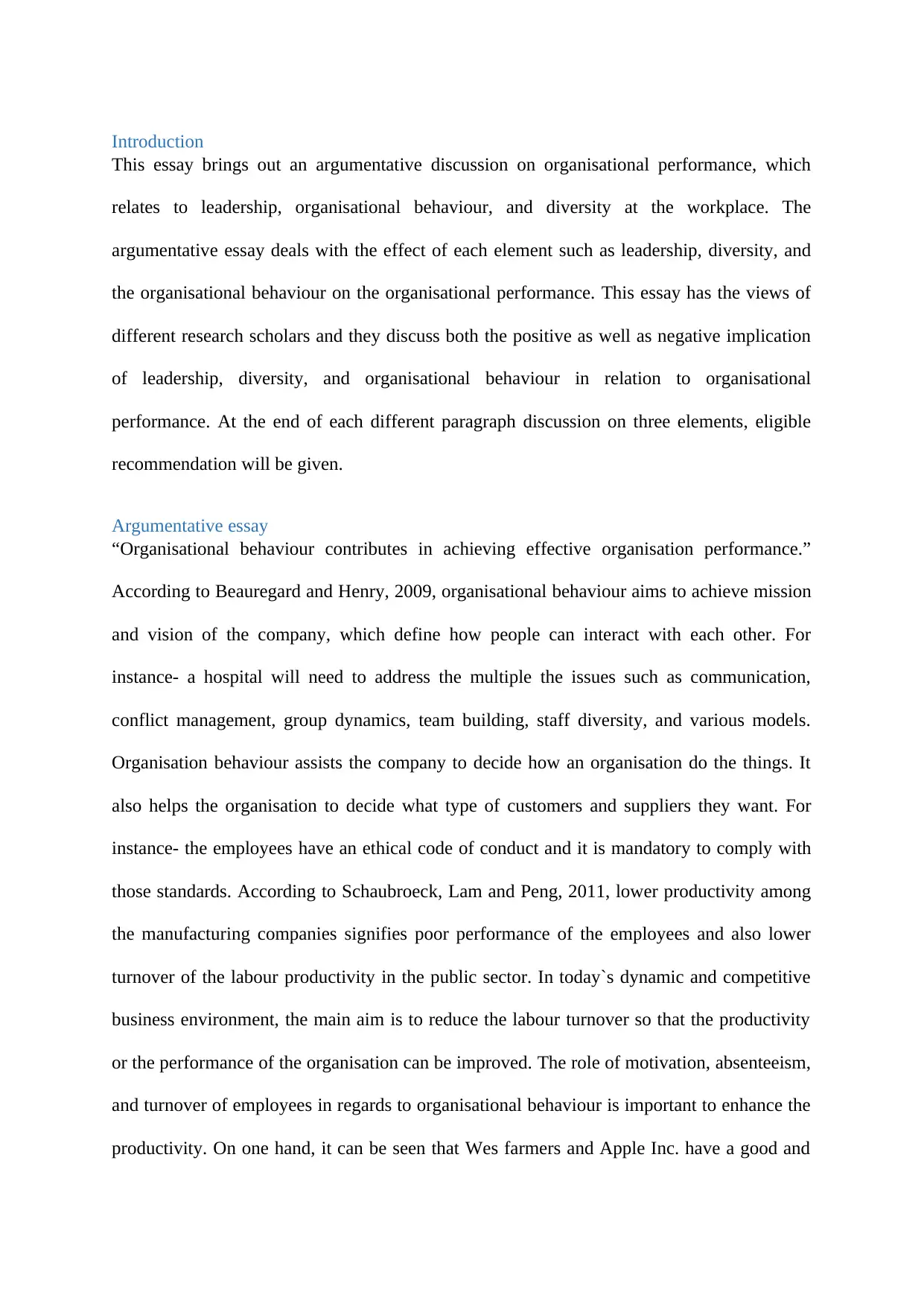
Introduction
This essay brings out an argumentative discussion on organisational performance, which
relates to leadership, organisational behaviour, and diversity at the workplace. The
argumentative essay deals with the effect of each element such as leadership, diversity, and
the organisational behaviour on the organisational performance. This essay has the views of
different research scholars and they discuss both the positive as well as negative implication
of leadership, diversity, and organisational behaviour in relation to organisational
performance. At the end of each different paragraph discussion on three elements, eligible
recommendation will be given.
Argumentative essay
“Organisational behaviour contributes in achieving effective organisation performance.”
According to Beauregard and Henry, 2009, organisational behaviour aims to achieve mission
and vision of the company, which define how people can interact with each other. For
instance- a hospital will need to address the multiple the issues such as communication,
conflict management, group dynamics, team building, staff diversity, and various models.
Organisation behaviour assists the company to decide how an organisation do the things. It
also helps the organisation to decide what type of customers and suppliers they want. For
instance- the employees have an ethical code of conduct and it is mandatory to comply with
those standards. According to Schaubroeck, Lam and Peng, 2011, lower productivity among
the manufacturing companies signifies poor performance of the employees and also lower
turnover of the labour productivity in the public sector. In today`s dynamic and competitive
business environment, the main aim is to reduce the labour turnover so that the productivity
or the performance of the organisation can be improved. The role of motivation, absenteeism,
and turnover of employees in regards to organisational behaviour is important to enhance the
productivity. On one hand, it can be seen that Wes farmers and Apple Inc. have a good and
This essay brings out an argumentative discussion on organisational performance, which
relates to leadership, organisational behaviour, and diversity at the workplace. The
argumentative essay deals with the effect of each element such as leadership, diversity, and
the organisational behaviour on the organisational performance. This essay has the views of
different research scholars and they discuss both the positive as well as negative implication
of leadership, diversity, and organisational behaviour in relation to organisational
performance. At the end of each different paragraph discussion on three elements, eligible
recommendation will be given.
Argumentative essay
“Organisational behaviour contributes in achieving effective organisation performance.”
According to Beauregard and Henry, 2009, organisational behaviour aims to achieve mission
and vision of the company, which define how people can interact with each other. For
instance- a hospital will need to address the multiple the issues such as communication,
conflict management, group dynamics, team building, staff diversity, and various models.
Organisation behaviour assists the company to decide how an organisation do the things. It
also helps the organisation to decide what type of customers and suppliers they want. For
instance- the employees have an ethical code of conduct and it is mandatory to comply with
those standards. According to Schaubroeck, Lam and Peng, 2011, lower productivity among
the manufacturing companies signifies poor performance of the employees and also lower
turnover of the labour productivity in the public sector. In today`s dynamic and competitive
business environment, the main aim is to reduce the labour turnover so that the productivity
or the performance of the organisation can be improved. The role of motivation, absenteeism,
and turnover of employees in regards to organisational behaviour is important to enhance the
productivity. On one hand, it can be seen that Wes farmers and Apple Inc. have a good and
⊘ This is a preview!⊘
Do you want full access?
Subscribe today to unlock all pages.

Trusted by 1+ million students worldwide

effective internal organisational culture that has team building, motivation by their leaders,
and cooperation in the team. According to Rego and Pina e Cunha, 2008, the focus of the
organisational culture shifted by creating culture that is more balanced so that work pressure
can be managed. Moreover, innovation and creativity are two important elements of the
Apple`s organisational culture. As per the research undertaken by Fu and Deshpande, 2014,
as it always remained a tough job for the managers to improve the effectiveness of the
employees. Motivational theories have suggested that motivated employees pretend to be
more creative, productive, and loyal for both their work as well as their employers. For
example- FIFA scandal predicts that in 2015, the president, and the two famous football
players in the corporation were witnessed red handed while taking bribery. This example
reflects that how higher authority spoiled the culture and organisational behaviour. According
to Bolino et al, 2013, Organisations always suffer from conflicts from team, employee, and
the organisation that affects the organisational behaviour. Some of the underlying reasons
relate to problems are lack of the communication flows and using the wrong organisational
issues. Problems such as employees’ issues, team problems, and other organisation related
problems spoils the organisational behaviour. Another practical example can be
mismanagement in the MacDonald is which occurred due to trust issues and jealousy for one
another among the employees had led to spoilage in the brand image of the organisation.
Personal conflicts, personal trauma, and supervisor issues hamper performance of the
organisation because if there is no clear communication among the employees and bonding
among the employees then it will result in fuelling the fire. For example- when the employees
work in a decentralised company inculcates that employees need to answer to several
supervisors especially when the chain of command is not communicated thoroughly.
According to Chiang and Hsieh, 2012, implications of an effective organisational behaviour
are increasing the productivity, employees, and employers can get high standard of living and
and cooperation in the team. According to Rego and Pina e Cunha, 2008, the focus of the
organisational culture shifted by creating culture that is more balanced so that work pressure
can be managed. Moreover, innovation and creativity are two important elements of the
Apple`s organisational culture. As per the research undertaken by Fu and Deshpande, 2014,
as it always remained a tough job for the managers to improve the effectiveness of the
employees. Motivational theories have suggested that motivated employees pretend to be
more creative, productive, and loyal for both their work as well as their employers. For
example- FIFA scandal predicts that in 2015, the president, and the two famous football
players in the corporation were witnessed red handed while taking bribery. This example
reflects that how higher authority spoiled the culture and organisational behaviour. According
to Bolino et al, 2013, Organisations always suffer from conflicts from team, employee, and
the organisation that affects the organisational behaviour. Some of the underlying reasons
relate to problems are lack of the communication flows and using the wrong organisational
issues. Problems such as employees’ issues, team problems, and other organisation related
problems spoils the organisational behaviour. Another practical example can be
mismanagement in the MacDonald is which occurred due to trust issues and jealousy for one
another among the employees had led to spoilage in the brand image of the organisation.
Personal conflicts, personal trauma, and supervisor issues hamper performance of the
organisation because if there is no clear communication among the employees and bonding
among the employees then it will result in fuelling the fire. For example- when the employees
work in a decentralised company inculcates that employees need to answer to several
supervisors especially when the chain of command is not communicated thoroughly.
According to Chiang and Hsieh, 2012, implications of an effective organisational behaviour
are increasing the productivity, employees, and employers can get high standard of living and
Paraphrase This Document
Need a fresh take? Get an instant paraphrase of this document with our AI Paraphraser
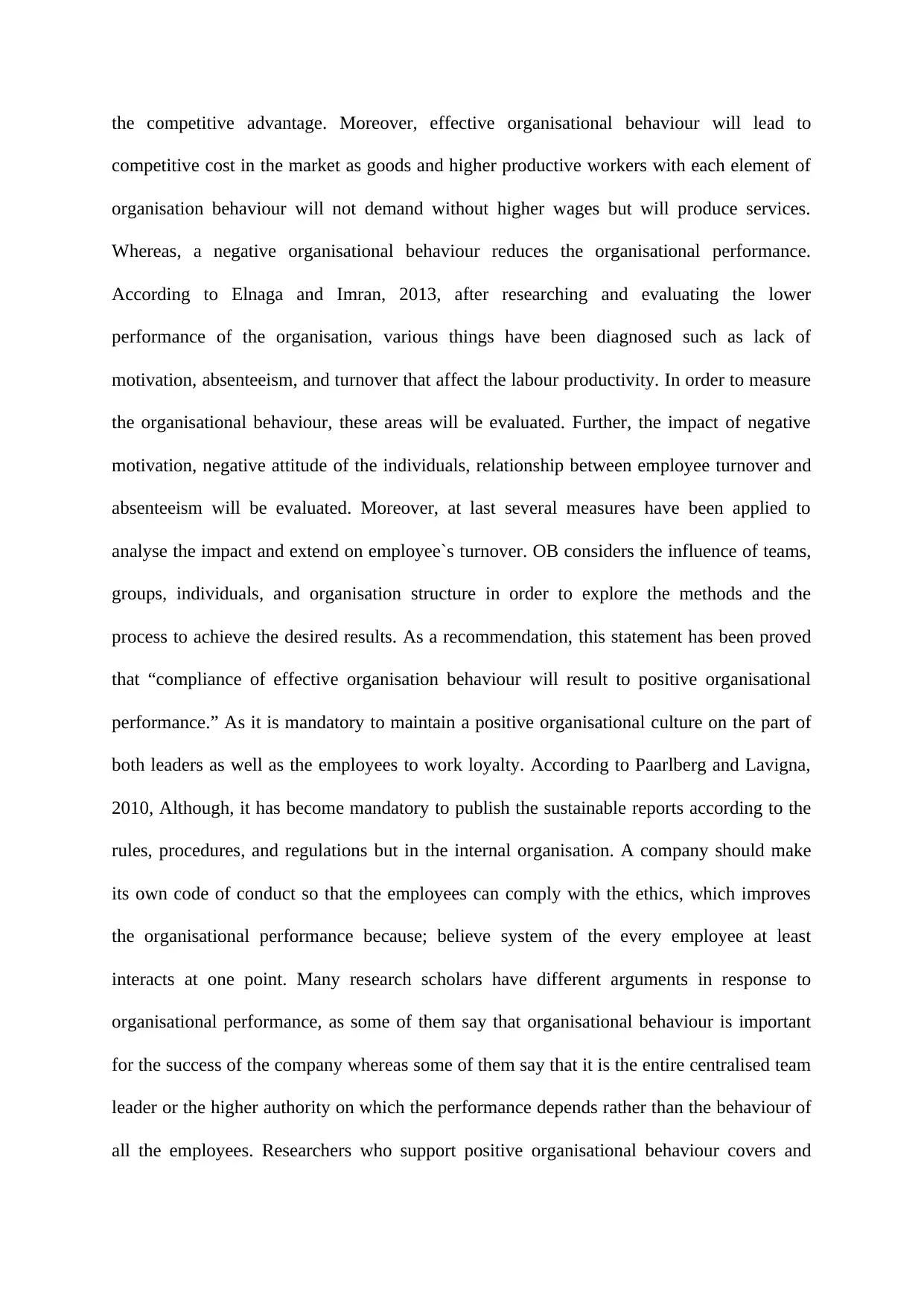
the competitive advantage. Moreover, effective organisational behaviour will lead to
competitive cost in the market as goods and higher productive workers with each element of
organisation behaviour will not demand without higher wages but will produce services.
Whereas, a negative organisational behaviour reduces the organisational performance.
According to Elnaga and Imran, 2013, after researching and evaluating the lower
performance of the organisation, various things have been diagnosed such as lack of
motivation, absenteeism, and turnover that affect the labour productivity. In order to measure
the organisational behaviour, these areas will be evaluated. Further, the impact of negative
motivation, negative attitude of the individuals, relationship between employee turnover and
absenteeism will be evaluated. Moreover, at last several measures have been applied to
analyse the impact and extend on employee`s turnover. OB considers the influence of teams,
groups, individuals, and organisation structure in order to explore the methods and the
process to achieve the desired results. As a recommendation, this statement has been proved
that “compliance of effective organisation behaviour will result to positive organisational
performance.” As it is mandatory to maintain a positive organisational culture on the part of
both leaders as well as the employees to work loyalty. According to Paarlberg and Lavigna,
2010, Although, it has become mandatory to publish the sustainable reports according to the
rules, procedures, and regulations but in the internal organisation. A company should make
its own code of conduct so that the employees can comply with the ethics, which improves
the organisational performance because; believe system of the every employee at least
interacts at one point. Many research scholars have different arguments in response to
organisational performance, as some of them say that organisational behaviour is important
for the success of the company whereas some of them say that it is the entire centralised team
leader or the higher authority on which the performance depends rather than the behaviour of
all the employees. Researchers who support positive organisational behaviour covers and
competitive cost in the market as goods and higher productive workers with each element of
organisation behaviour will not demand without higher wages but will produce services.
Whereas, a negative organisational behaviour reduces the organisational performance.
According to Elnaga and Imran, 2013, after researching and evaluating the lower
performance of the organisation, various things have been diagnosed such as lack of
motivation, absenteeism, and turnover that affect the labour productivity. In order to measure
the organisational behaviour, these areas will be evaluated. Further, the impact of negative
motivation, negative attitude of the individuals, relationship between employee turnover and
absenteeism will be evaluated. Moreover, at last several measures have been applied to
analyse the impact and extend on employee`s turnover. OB considers the influence of teams,
groups, individuals, and organisation structure in order to explore the methods and the
process to achieve the desired results. As a recommendation, this statement has been proved
that “compliance of effective organisation behaviour will result to positive organisational
performance.” As it is mandatory to maintain a positive organisational culture on the part of
both leaders as well as the employees to work loyalty. According to Paarlberg and Lavigna,
2010, Although, it has become mandatory to publish the sustainable reports according to the
rules, procedures, and regulations but in the internal organisation. A company should make
its own code of conduct so that the employees can comply with the ethics, which improves
the organisational performance because; believe system of the every employee at least
interacts at one point. Many research scholars have different arguments in response to
organisational performance, as some of them say that organisational behaviour is important
for the success of the company whereas some of them say that it is the entire centralised team
leader or the higher authority on which the performance depends rather than the behaviour of
all the employees. Researchers who support positive organisational behaviour covers and
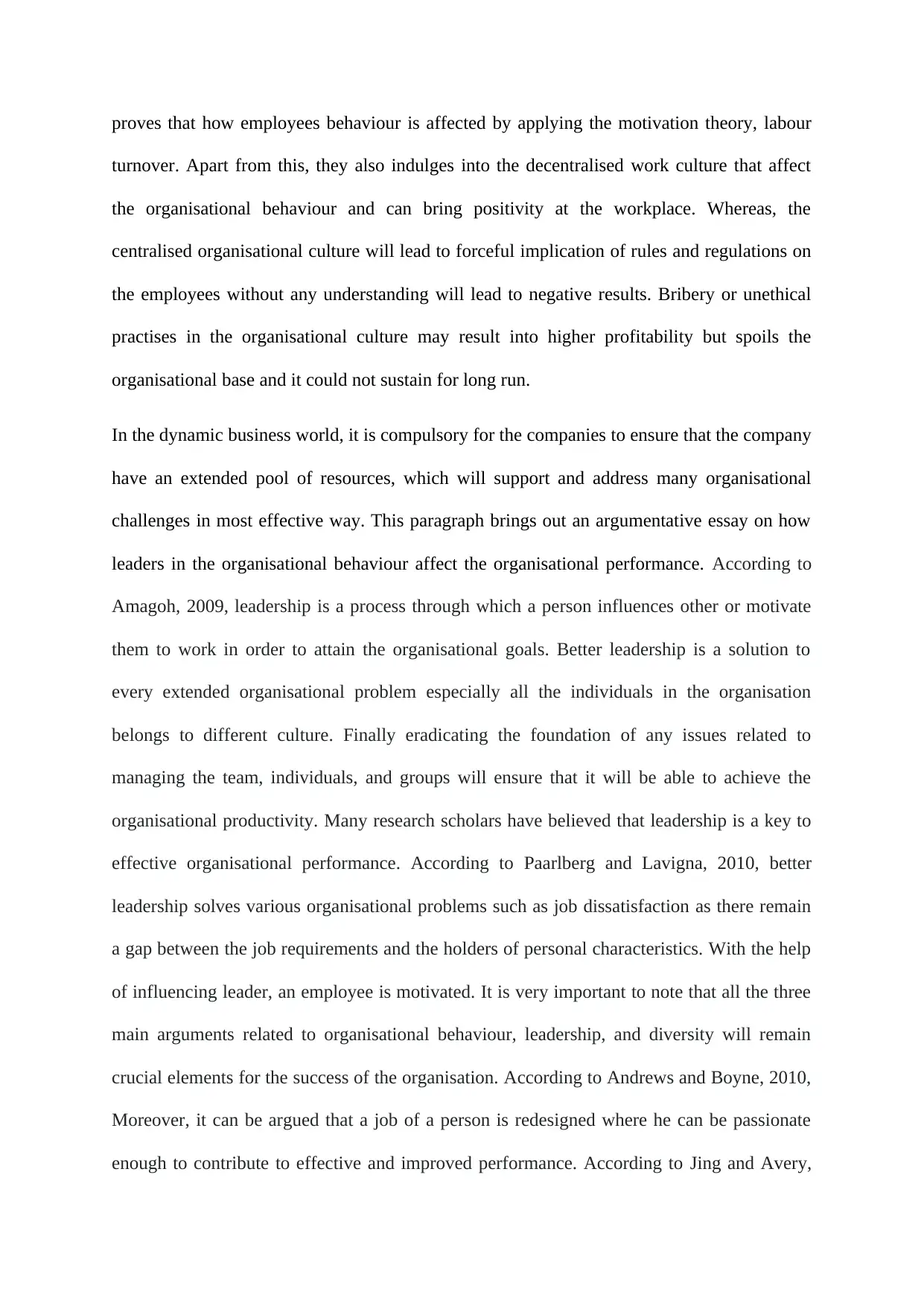
proves that how employees behaviour is affected by applying the motivation theory, labour
turnover. Apart from this, they also indulges into the decentralised work culture that affect
the organisational behaviour and can bring positivity at the workplace. Whereas, the
centralised organisational culture will lead to forceful implication of rules and regulations on
the employees without any understanding will lead to negative results. Bribery or unethical
practises in the organisational culture may result into higher profitability but spoils the
organisational base and it could not sustain for long run.
In the dynamic business world, it is compulsory for the companies to ensure that the company
have an extended pool of resources, which will support and address many organisational
challenges in most effective way. This paragraph brings out an argumentative essay on how
leaders in the organisational behaviour affect the organisational performance. According to
Amagoh, 2009, leadership is a process through which a person influences other or motivate
them to work in order to attain the organisational goals. Better leadership is a solution to
every extended organisational problem especially all the individuals in the organisation
belongs to different culture. Finally eradicating the foundation of any issues related to
managing the team, individuals, and groups will ensure that it will be able to achieve the
organisational productivity. Many research scholars have believed that leadership is a key to
effective organisational performance. According to Paarlberg and Lavigna, 2010, better
leadership solves various organisational problems such as job dissatisfaction as there remain
a gap between the job requirements and the holders of personal characteristics. With the help
of influencing leader, an employee is motivated. It is very important to note that all the three
main arguments related to organisational behaviour, leadership, and diversity will remain
crucial elements for the success of the organisation. According to Andrews and Boyne, 2010,
Moreover, it can be argued that a job of a person is redesigned where he can be passionate
enough to contribute to effective and improved performance. According to Jing and Avery,
turnover. Apart from this, they also indulges into the decentralised work culture that affect
the organisational behaviour and can bring positivity at the workplace. Whereas, the
centralised organisational culture will lead to forceful implication of rules and regulations on
the employees without any understanding will lead to negative results. Bribery or unethical
practises in the organisational culture may result into higher profitability but spoils the
organisational base and it could not sustain for long run.
In the dynamic business world, it is compulsory for the companies to ensure that the company
have an extended pool of resources, which will support and address many organisational
challenges in most effective way. This paragraph brings out an argumentative essay on how
leaders in the organisational behaviour affect the organisational performance. According to
Amagoh, 2009, leadership is a process through which a person influences other or motivate
them to work in order to attain the organisational goals. Better leadership is a solution to
every extended organisational problem especially all the individuals in the organisation
belongs to different culture. Finally eradicating the foundation of any issues related to
managing the team, individuals, and groups will ensure that it will be able to achieve the
organisational productivity. Many research scholars have believed that leadership is a key to
effective organisational performance. According to Paarlberg and Lavigna, 2010, better
leadership solves various organisational problems such as job dissatisfaction as there remain
a gap between the job requirements and the holders of personal characteristics. With the help
of influencing leader, an employee is motivated. It is very important to note that all the three
main arguments related to organisational behaviour, leadership, and diversity will remain
crucial elements for the success of the organisation. According to Andrews and Boyne, 2010,
Moreover, it can be argued that a job of a person is redesigned where he can be passionate
enough to contribute to effective and improved performance. According to Jing and Avery,
⊘ This is a preview!⊘
Do you want full access?
Subscribe today to unlock all pages.

Trusted by 1+ million students worldwide
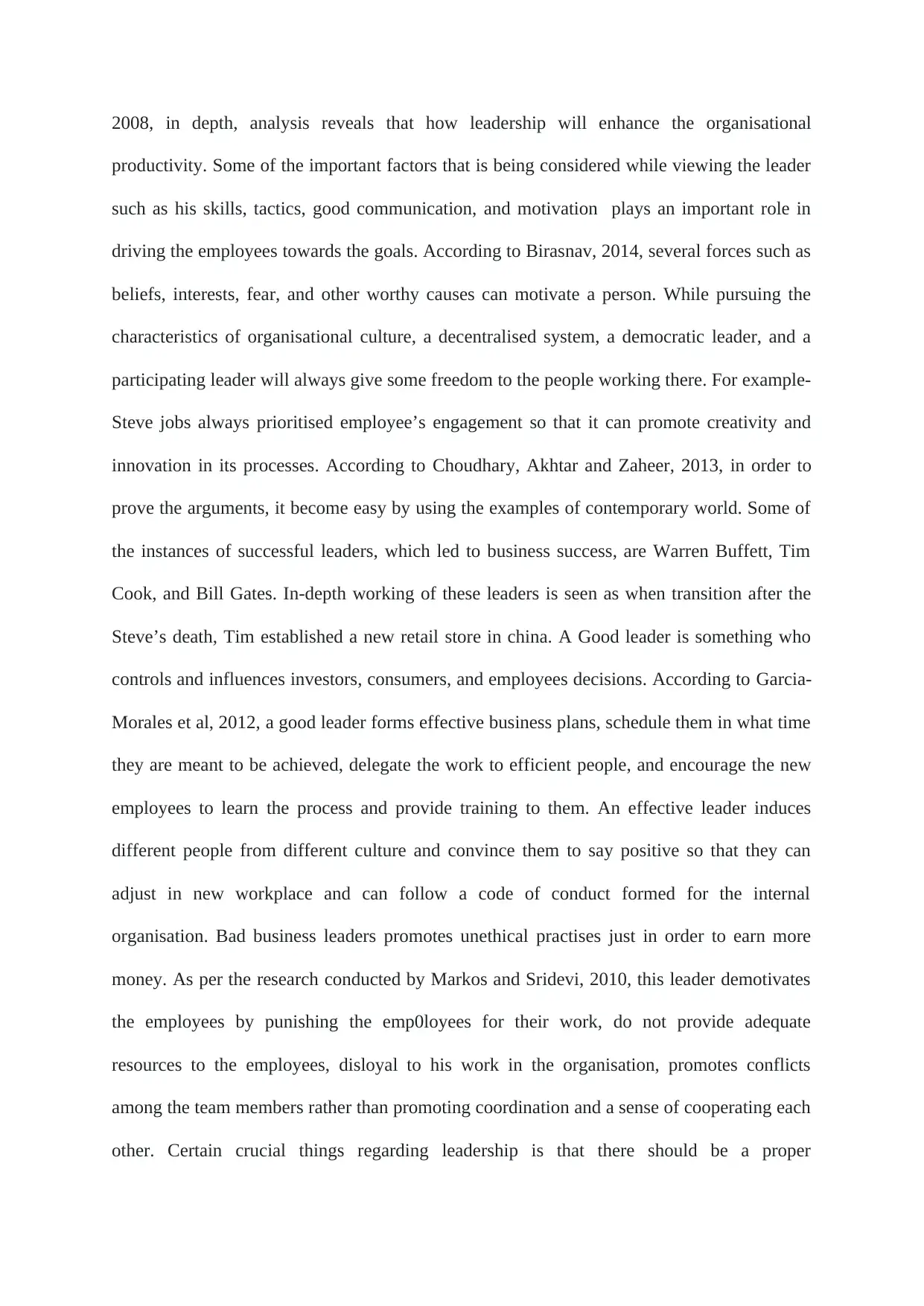
2008, in depth, analysis reveals that how leadership will enhance the organisational
productivity. Some of the important factors that is being considered while viewing the leader
such as his skills, tactics, good communication, and motivation plays an important role in
driving the employees towards the goals. According to Birasnav, 2014, several forces such as
beliefs, interests, fear, and other worthy causes can motivate a person. While pursuing the
characteristics of organisational culture, a decentralised system, a democratic leader, and a
participating leader will always give some freedom to the people working there. For example-
Steve jobs always prioritised employee’s engagement so that it can promote creativity and
innovation in its processes. According to Choudhary, Akhtar and Zaheer, 2013, in order to
prove the arguments, it become easy by using the examples of contemporary world. Some of
the instances of successful leaders, which led to business success, are Warren Buffett, Tim
Cook, and Bill Gates. In-depth working of these leaders is seen as when transition after the
Steve’s death, Tim established a new retail store in china. A Good leader is something who
controls and influences investors, consumers, and employees decisions. According to Garcia-
Morales et al, 2012, a good leader forms effective business plans, schedule them in what time
they are meant to be achieved, delegate the work to efficient people, and encourage the new
employees to learn the process and provide training to them. An effective leader induces
different people from different culture and convince them to say positive so that they can
adjust in new workplace and can follow a code of conduct formed for the internal
organisation. Bad business leaders promotes unethical practises just in order to earn more
money. As per the research conducted by Markos and Sridevi, 2010, this leader demotivates
the employees by punishing the emp0loyees for their work, do not provide adequate
resources to the employees, disloyal to his work in the organisation, promotes conflicts
among the team members rather than promoting coordination and a sense of cooperating each
other. Certain crucial things regarding leadership is that there should be a proper
productivity. Some of the important factors that is being considered while viewing the leader
such as his skills, tactics, good communication, and motivation plays an important role in
driving the employees towards the goals. According to Birasnav, 2014, several forces such as
beliefs, interests, fear, and other worthy causes can motivate a person. While pursuing the
characteristics of organisational culture, a decentralised system, a democratic leader, and a
participating leader will always give some freedom to the people working there. For example-
Steve jobs always prioritised employee’s engagement so that it can promote creativity and
innovation in its processes. According to Choudhary, Akhtar and Zaheer, 2013, in order to
prove the arguments, it become easy by using the examples of contemporary world. Some of
the instances of successful leaders, which led to business success, are Warren Buffett, Tim
Cook, and Bill Gates. In-depth working of these leaders is seen as when transition after the
Steve’s death, Tim established a new retail store in china. A Good leader is something who
controls and influences investors, consumers, and employees decisions. According to Garcia-
Morales et al, 2012, a good leader forms effective business plans, schedule them in what time
they are meant to be achieved, delegate the work to efficient people, and encourage the new
employees to learn the process and provide training to them. An effective leader induces
different people from different culture and convince them to say positive so that they can
adjust in new workplace and can follow a code of conduct formed for the internal
organisation. Bad business leaders promotes unethical practises just in order to earn more
money. As per the research conducted by Markos and Sridevi, 2010, this leader demotivates
the employees by punishing the emp0loyees for their work, do not provide adequate
resources to the employees, disloyal to his work in the organisation, promotes conflicts
among the team members rather than promoting coordination and a sense of cooperating each
other. Certain crucial things regarding leadership is that there should be a proper
Paraphrase This Document
Need a fresh take? Get an instant paraphrase of this document with our AI Paraphraser
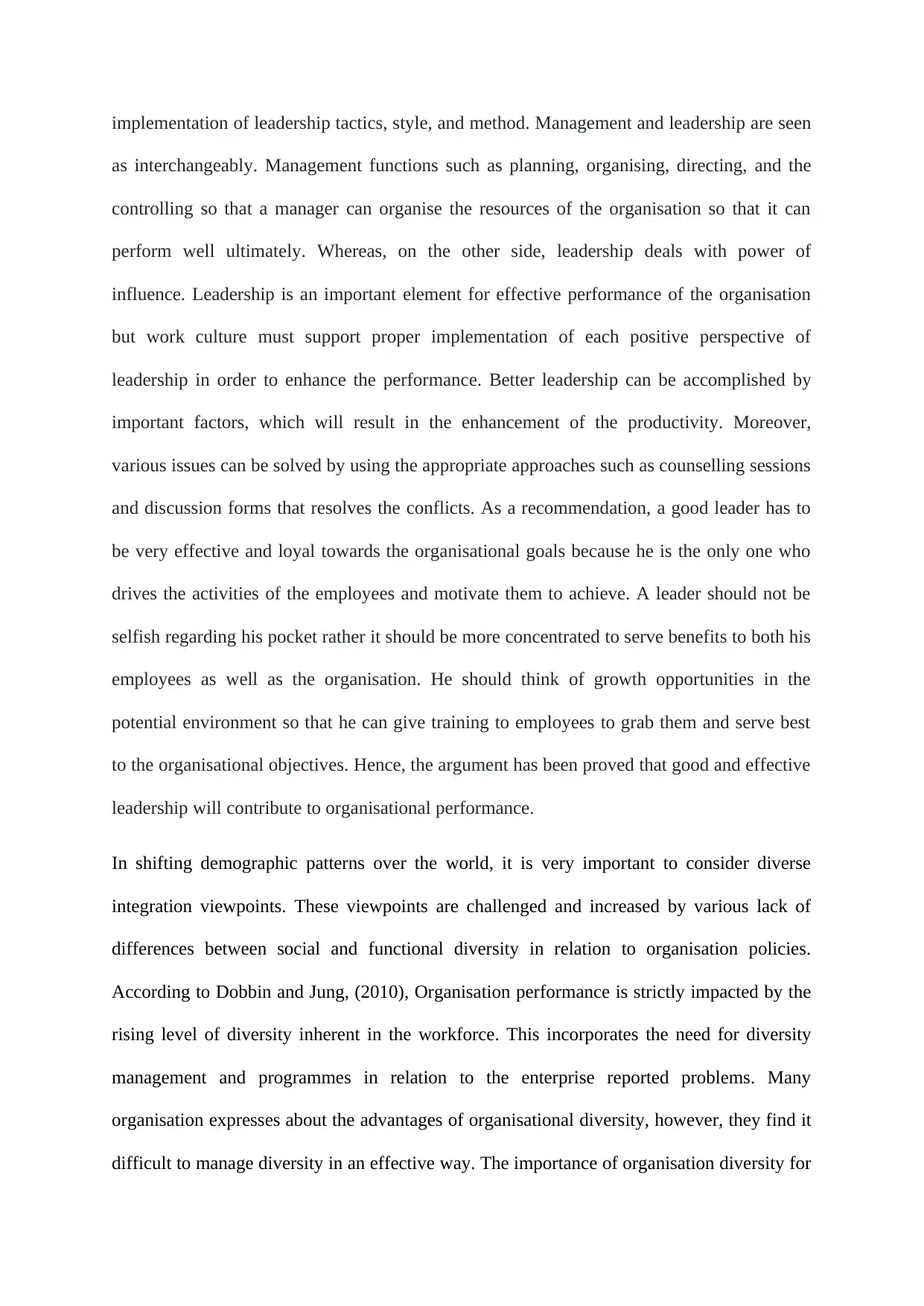
implementation of leadership tactics, style, and method. Management and leadership are seen
as interchangeably. Management functions such as planning, organising, directing, and the
controlling so that a manager can organise the resources of the organisation so that it can
perform well ultimately. Whereas, on the other side, leadership deals with power of
influence. Leadership is an important element for effective performance of the organisation
but work culture must support proper implementation of each positive perspective of
leadership in order to enhance the performance. Better leadership can be accomplished by
important factors, which will result in the enhancement of the productivity. Moreover,
various issues can be solved by using the appropriate approaches such as counselling sessions
and discussion forms that resolves the conflicts. As a recommendation, a good leader has to
be very effective and loyal towards the organisational goals because he is the only one who
drives the activities of the employees and motivate them to achieve. A leader should not be
selfish regarding his pocket rather it should be more concentrated to serve benefits to both his
employees as well as the organisation. He should think of growth opportunities in the
potential environment so that he can give training to employees to grab them and serve best
to the organisational objectives. Hence, the argument has been proved that good and effective
leadership will contribute to organisational performance.
In shifting demographic patterns over the world, it is very important to consider diverse
integration viewpoints. These viewpoints are challenged and increased by various lack of
differences between social and functional diversity in relation to organisation policies.
According to Dobbin and Jung, (2010), Organisation performance is strictly impacted by the
rising level of diversity inherent in the workforce. This incorporates the need for diversity
management and programmes in relation to the enterprise reported problems. Many
organisation expresses about the advantages of organisational diversity, however, they find it
difficult to manage diversity in an effective way. The importance of organisation diversity for
as interchangeably. Management functions such as planning, organising, directing, and the
controlling so that a manager can organise the resources of the organisation so that it can
perform well ultimately. Whereas, on the other side, leadership deals with power of
influence. Leadership is an important element for effective performance of the organisation
but work culture must support proper implementation of each positive perspective of
leadership in order to enhance the performance. Better leadership can be accomplished by
important factors, which will result in the enhancement of the productivity. Moreover,
various issues can be solved by using the appropriate approaches such as counselling sessions
and discussion forms that resolves the conflicts. As a recommendation, a good leader has to
be very effective and loyal towards the organisational goals because he is the only one who
drives the activities of the employees and motivate them to achieve. A leader should not be
selfish regarding his pocket rather it should be more concentrated to serve benefits to both his
employees as well as the organisation. He should think of growth opportunities in the
potential environment so that he can give training to employees to grab them and serve best
to the organisational objectives. Hence, the argument has been proved that good and effective
leadership will contribute to organisational performance.
In shifting demographic patterns over the world, it is very important to consider diverse
integration viewpoints. These viewpoints are challenged and increased by various lack of
differences between social and functional diversity in relation to organisation policies.
According to Dobbin and Jung, (2010), Organisation performance is strictly impacted by the
rising level of diversity inherent in the workforce. This incorporates the need for diversity
management and programmes in relation to the enterprise reported problems. Many
organisation expresses about the advantages of organisational diversity, however, they find it
difficult to manage diversity in an effective way. The importance of organisation diversity for
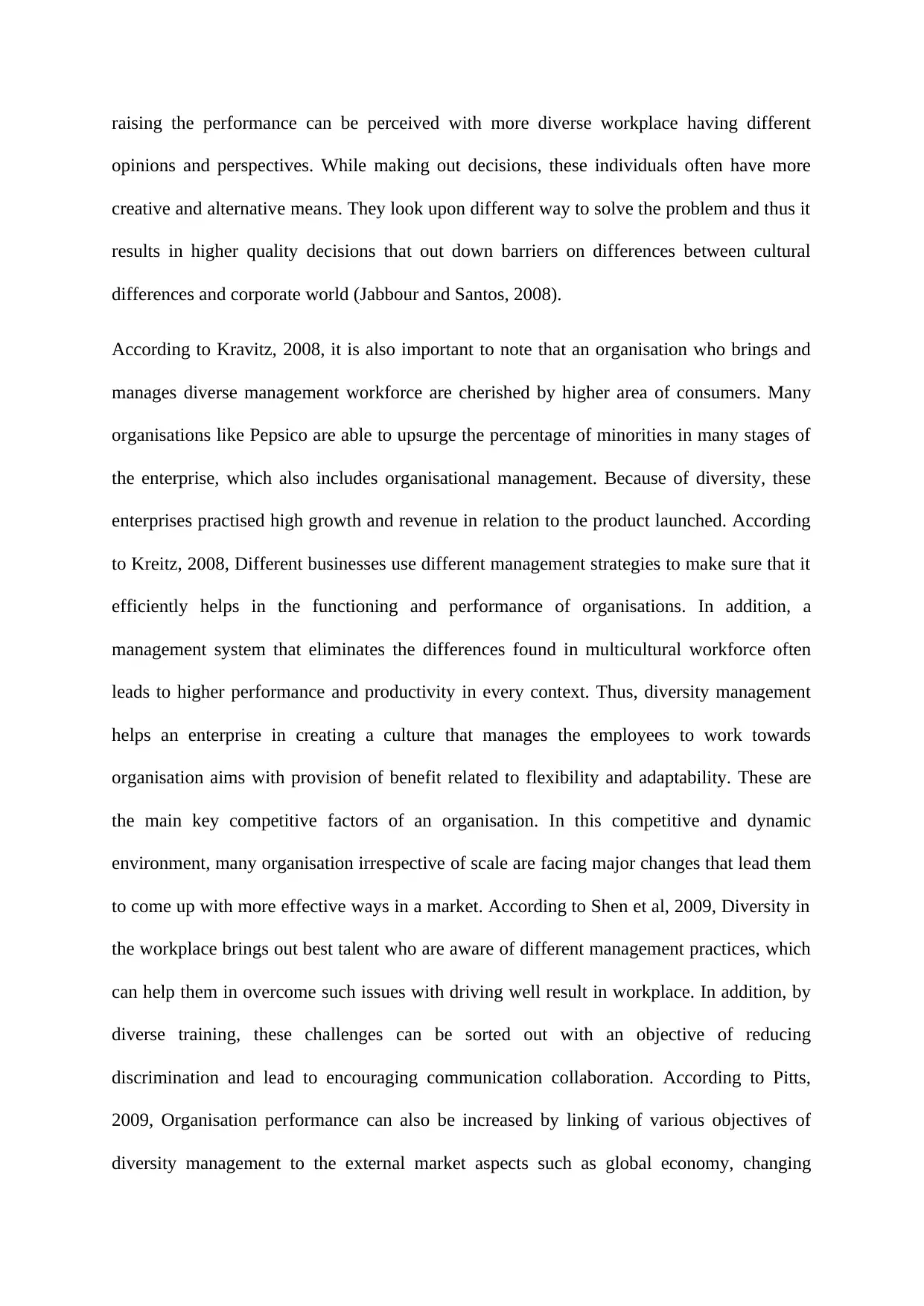
raising the performance can be perceived with more diverse workplace having different
opinions and perspectives. While making out decisions, these individuals often have more
creative and alternative means. They look upon different way to solve the problem and thus it
results in higher quality decisions that out down barriers on differences between cultural
differences and corporate world (Jabbour and Santos, 2008).
According to Kravitz, 2008, it is also important to note that an organisation who brings and
manages diverse management workforce are cherished by higher area of consumers. Many
organisations like Pepsico are able to upsurge the percentage of minorities in many stages of
the enterprise, which also includes organisational management. Because of diversity, these
enterprises practised high growth and revenue in relation to the product launched. According
to Kreitz, 2008, Different businesses use different management strategies to make sure that it
efficiently helps in the functioning and performance of organisations. In addition, a
management system that eliminates the differences found in multicultural workforce often
leads to higher performance and productivity in every context. Thus, diversity management
helps an enterprise in creating a culture that manages the employees to work towards
organisation aims with provision of benefit related to flexibility and adaptability. These are
the main key competitive factors of an organisation. In this competitive and dynamic
environment, many organisation irrespective of scale are facing major changes that lead them
to come up with more effective ways in a market. According to Shen et al, 2009, Diversity in
the workplace brings out best talent who are aware of different management practices, which
can help them in overcome such issues with driving well result in workplace. In addition, by
diverse training, these challenges can be sorted out with an objective of reducing
discrimination and lead to encouraging communication collaboration. According to Pitts,
2009, Organisation performance can also be increased by linking of various objectives of
diversity management to the external market aspects such as global economy, changing
opinions and perspectives. While making out decisions, these individuals often have more
creative and alternative means. They look upon different way to solve the problem and thus it
results in higher quality decisions that out down barriers on differences between cultural
differences and corporate world (Jabbour and Santos, 2008).
According to Kravitz, 2008, it is also important to note that an organisation who brings and
manages diverse management workforce are cherished by higher area of consumers. Many
organisations like Pepsico are able to upsurge the percentage of minorities in many stages of
the enterprise, which also includes organisational management. Because of diversity, these
enterprises practised high growth and revenue in relation to the product launched. According
to Kreitz, 2008, Different businesses use different management strategies to make sure that it
efficiently helps in the functioning and performance of organisations. In addition, a
management system that eliminates the differences found in multicultural workforce often
leads to higher performance and productivity in every context. Thus, diversity management
helps an enterprise in creating a culture that manages the employees to work towards
organisation aims with provision of benefit related to flexibility and adaptability. These are
the main key competitive factors of an organisation. In this competitive and dynamic
environment, many organisation irrespective of scale are facing major changes that lead them
to come up with more effective ways in a market. According to Shen et al, 2009, Diversity in
the workplace brings out best talent who are aware of different management practices, which
can help them in overcome such issues with driving well result in workplace. In addition, by
diverse training, these challenges can be sorted out with an objective of reducing
discrimination and lead to encouraging communication collaboration. According to Pitts,
2009, Organisation performance can also be increased by linking of various objectives of
diversity management to the external market aspects such as global economy, changing
⊘ This is a preview!⊘
Do you want full access?
Subscribe today to unlock all pages.

Trusted by 1+ million students worldwide
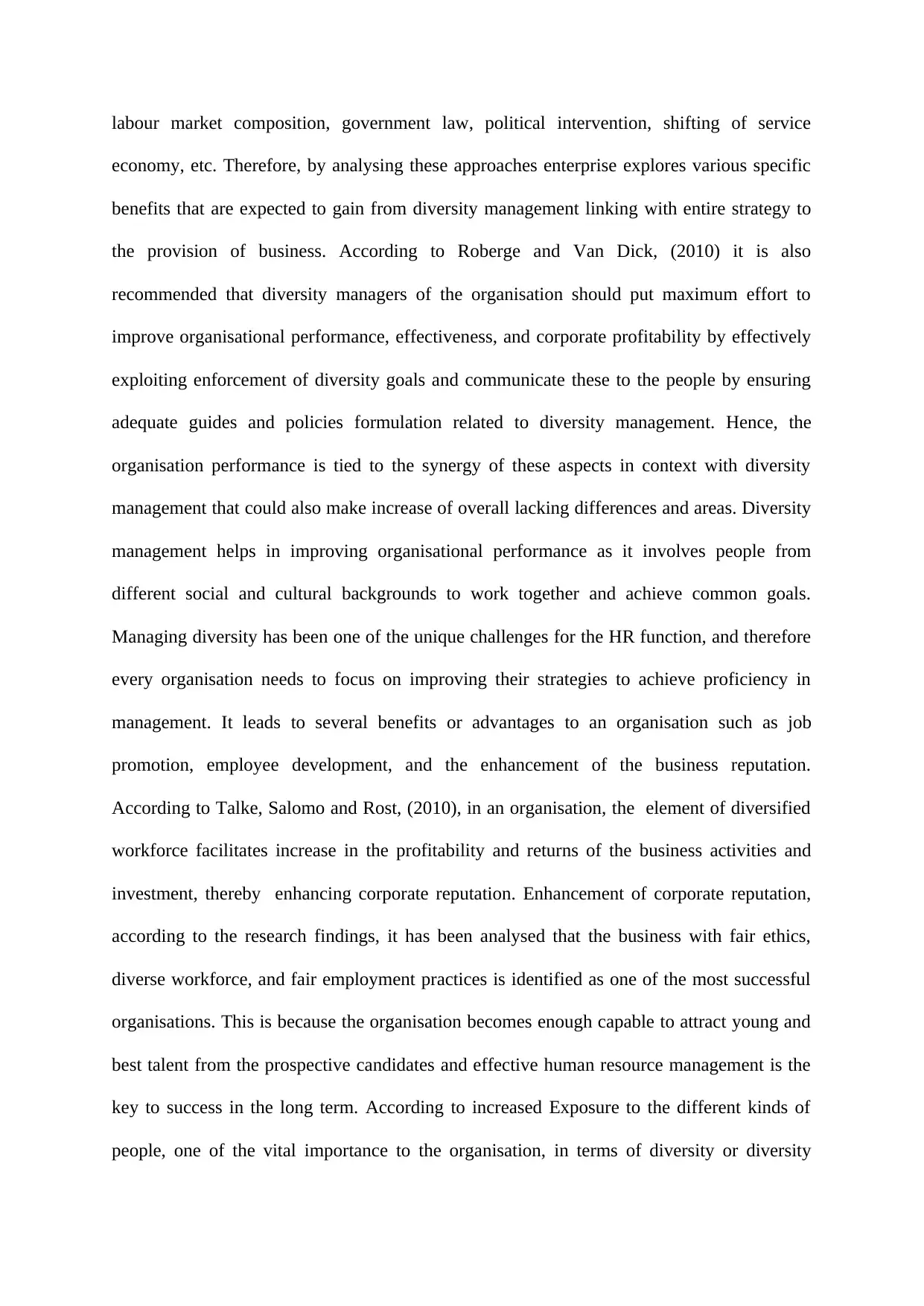
labour market composition, government law, political intervention, shifting of service
economy, etc. Therefore, by analysing these approaches enterprise explores various specific
benefits that are expected to gain from diversity management linking with entire strategy to
the provision of business. According to Roberge and Van Dick, (2010) it is also
recommended that diversity managers of the organisation should put maximum effort to
improve organisational performance, effectiveness, and corporate profitability by effectively
exploiting enforcement of diversity goals and communicate these to the people by ensuring
adequate guides and policies formulation related to diversity management. Hence, the
organisation performance is tied to the synergy of these aspects in context with diversity
management that could also make increase of overall lacking differences and areas. Diversity
management helps in improving organisational performance as it involves people from
different social and cultural backgrounds to work together and achieve common goals.
Managing diversity has been one of the unique challenges for the HR function, and therefore
every organisation needs to focus on improving their strategies to achieve proficiency in
management. It leads to several benefits or advantages to an organisation such as job
promotion, employee development, and the enhancement of the business reputation.
According to Talke, Salomo and Rost, (2010), in an organisation, the element of diversified
workforce facilitates increase in the profitability and returns of the business activities and
investment, thereby enhancing corporate reputation. Enhancement of corporate reputation,
according to the research findings, it has been analysed that the business with fair ethics,
diverse workforce, and fair employment practices is identified as one of the most successful
organisations. This is because the organisation becomes enough capable to attract young and
best talent from the prospective candidates and effective human resource management is the
key to success in the long term. According to increased Exposure to the different kinds of
people, one of the vital importance to the organisation, in terms of diversity or diversity
economy, etc. Therefore, by analysing these approaches enterprise explores various specific
benefits that are expected to gain from diversity management linking with entire strategy to
the provision of business. According to Roberge and Van Dick, (2010) it is also
recommended that diversity managers of the organisation should put maximum effort to
improve organisational performance, effectiveness, and corporate profitability by effectively
exploiting enforcement of diversity goals and communicate these to the people by ensuring
adequate guides and policies formulation related to diversity management. Hence, the
organisation performance is tied to the synergy of these aspects in context with diversity
management that could also make increase of overall lacking differences and areas. Diversity
management helps in improving organisational performance as it involves people from
different social and cultural backgrounds to work together and achieve common goals.
Managing diversity has been one of the unique challenges for the HR function, and therefore
every organisation needs to focus on improving their strategies to achieve proficiency in
management. It leads to several benefits or advantages to an organisation such as job
promotion, employee development, and the enhancement of the business reputation.
According to Talke, Salomo and Rost, (2010), in an organisation, the element of diversified
workforce facilitates increase in the profitability and returns of the business activities and
investment, thereby enhancing corporate reputation. Enhancement of corporate reputation,
according to the research findings, it has been analysed that the business with fair ethics,
diverse workforce, and fair employment practices is identified as one of the most successful
organisations. This is because the organisation becomes enough capable to attract young and
best talent from the prospective candidates and effective human resource management is the
key to success in the long term. According to increased Exposure to the different kinds of
people, one of the vital importance to the organisation, in terms of diversity or diversity
Paraphrase This Document
Need a fresh take? Get an instant paraphrase of this document with our AI Paraphraser
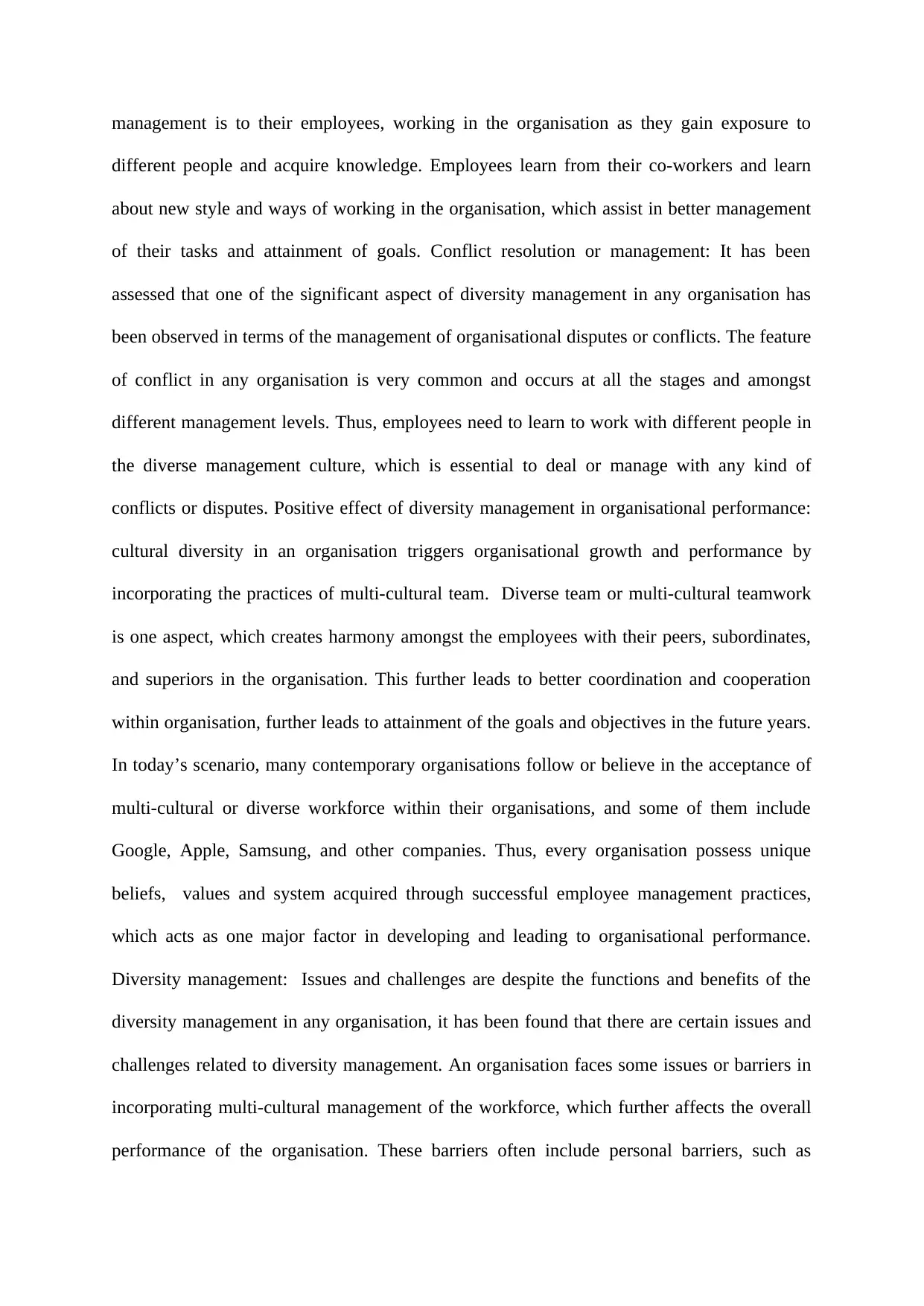
management is to their employees, working in the organisation as they gain exposure to
different people and acquire knowledge. Employees learn from their co-workers and learn
about new style and ways of working in the organisation, which assist in better management
of their tasks and attainment of goals. Conflict resolution or management: It has been
assessed that one of the significant aspect of diversity management in any organisation has
been observed in terms of the management of organisational disputes or conflicts. The feature
of conflict in any organisation is very common and occurs at all the stages and amongst
different management levels. Thus, employees need to learn to work with different people in
the diverse management culture, which is essential to deal or manage with any kind of
conflicts or disputes. Positive effect of diversity management in organisational performance:
cultural diversity in an organisation triggers organisational growth and performance by
incorporating the practices of multi-cultural team. Diverse team or multi-cultural teamwork
is one aspect, which creates harmony amongst the employees with their peers, subordinates,
and superiors in the organisation. This further leads to better coordination and cooperation
within organisation, further leads to attainment of the goals and objectives in the future years.
In today’s scenario, many contemporary organisations follow or believe in the acceptance of
multi-cultural or diverse workforce within their organisations, and some of them include
Google, Apple, Samsung, and other companies. Thus, every organisation possess unique
beliefs, values and system acquired through successful employee management practices,
which acts as one major factor in developing and leading to organisational performance.
Diversity management: Issues and challenges are despite the functions and benefits of the
diversity management in any organisation, it has been found that there are certain issues and
challenges related to diversity management. An organisation faces some issues or barriers in
incorporating multi-cultural management of the workforce, which further affects the overall
performance of the organisation. These barriers often include personal barriers, such as
different people and acquire knowledge. Employees learn from their co-workers and learn
about new style and ways of working in the organisation, which assist in better management
of their tasks and attainment of goals. Conflict resolution or management: It has been
assessed that one of the significant aspect of diversity management in any organisation has
been observed in terms of the management of organisational disputes or conflicts. The feature
of conflict in any organisation is very common and occurs at all the stages and amongst
different management levels. Thus, employees need to learn to work with different people in
the diverse management culture, which is essential to deal or manage with any kind of
conflicts or disputes. Positive effect of diversity management in organisational performance:
cultural diversity in an organisation triggers organisational growth and performance by
incorporating the practices of multi-cultural team. Diverse team or multi-cultural teamwork
is one aspect, which creates harmony amongst the employees with their peers, subordinates,
and superiors in the organisation. This further leads to better coordination and cooperation
within organisation, further leads to attainment of the goals and objectives in the future years.
In today’s scenario, many contemporary organisations follow or believe in the acceptance of
multi-cultural or diverse workforce within their organisations, and some of them include
Google, Apple, Samsung, and other companies. Thus, every organisation possess unique
beliefs, values and system acquired through successful employee management practices,
which acts as one major factor in developing and leading to organisational performance.
Diversity management: Issues and challenges are despite the functions and benefits of the
diversity management in any organisation, it has been found that there are certain issues and
challenges related to diversity management. An organisation faces some issues or barriers in
incorporating multi-cultural management of the workforce, which further affects the overall
performance of the organisation. These barriers often include personal barriers, such as
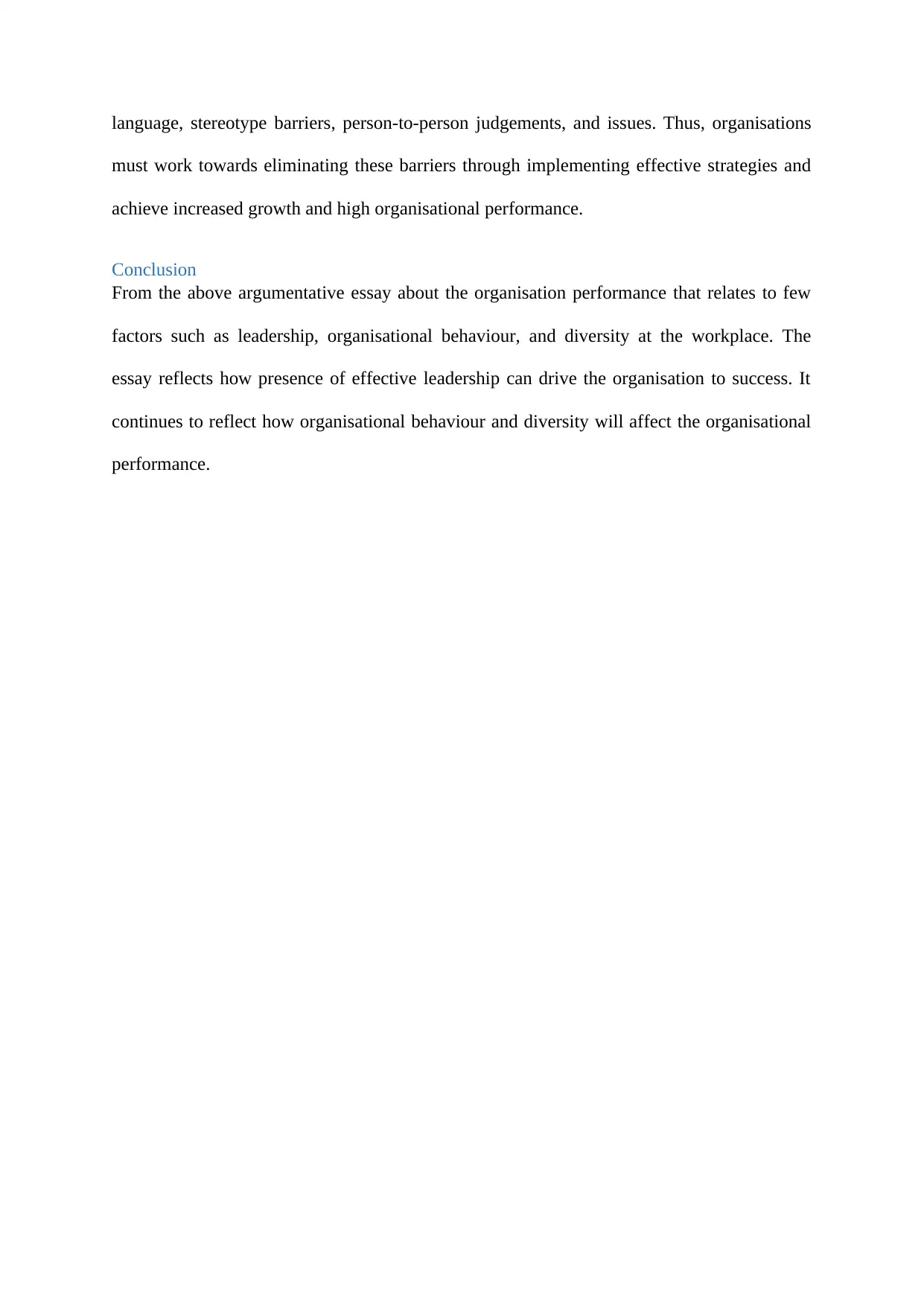
language, stereotype barriers, person-to-person judgements, and issues. Thus, organisations
must work towards eliminating these barriers through implementing effective strategies and
achieve increased growth and high organisational performance.
Conclusion
From the above argumentative essay about the organisation performance that relates to few
factors such as leadership, organisational behaviour, and diversity at the workplace. The
essay reflects how presence of effective leadership can drive the organisation to success. It
continues to reflect how organisational behaviour and diversity will affect the organisational
performance.
must work towards eliminating these barriers through implementing effective strategies and
achieve increased growth and high organisational performance.
Conclusion
From the above argumentative essay about the organisation performance that relates to few
factors such as leadership, organisational behaviour, and diversity at the workplace. The
essay reflects how presence of effective leadership can drive the organisation to success. It
continues to reflect how organisational behaviour and diversity will affect the organisational
performance.
⊘ This is a preview!⊘
Do you want full access?
Subscribe today to unlock all pages.

Trusted by 1+ million students worldwide
1 out of 16
Related Documents
Your All-in-One AI-Powered Toolkit for Academic Success.
+13062052269
info@desklib.com
Available 24*7 on WhatsApp / Email
![[object Object]](/_next/static/media/star-bottom.7253800d.svg)
Unlock your academic potential
Copyright © 2020–2025 A2Z Services. All Rights Reserved. Developed and managed by ZUCOL.





